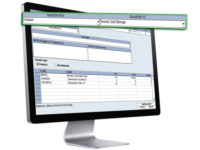Companies often use warehouse management system (WMS) software to track traffic in and out of the warehouse. These systems are often a component of a larger enterprise resource planning (ERP) system. An effective WMS helps ensure that companies have what they need for production each day, and there’s no wait while ordering ingredients and other necessities. Companies can track ingredients, packaging, and other materials through software management tools, and new offerings are becoming available every year.
Managing traffic
Managing traffic in and out of the warehouse is an important facet of snack and bakery businesses.
“We offer a WMS alternative software solution for ERP called RFgen Warehouse Director,” says Robert Brice, president, RFgen Software, El Dorado Hills, CA. “Warehouse Director provides next-level optimizations by equipping warehouses with intelligently generated pick routing for workers and suggestion-based directed movement for materials during put-away, replenishment, and picking procedures.”
For inbound/outbound traffic, Warehouse Director can designate certain bays for receiving, shipment, or cross-docking, eliminating bottlenecks from mixed traffic attempting to use the same doors on an ad-hoc basis, adds Brice.
Derek Curtis, VP of sales retail execution, HighJump/Kӧrber Supply Chain, Hamburg, Germany, says that new software is best handled by its solution for retail execution/direct store delivery (DSD). “With the continued expansion of independent business ownership in the snack/bakery business, we have added considerable functionality to aid in the management of the ‘shopping’ process. This includes the IBO (or franchisee) used to buy/pick up products when they are coming into the source/manufacturer warehouse.”
Ash Matthews, product expert, FlexiBake, Vancouver, British Columbia, says that FlexiBake helps to manage inventory movement not only coming and going from the warehouse, but within it, as well. “Through production, raw material movement can be followed into work-in-progress inventory and then into products, and this movement is recorded to provide full lot tracking and product traceability at the click of a button in the case of an audit or mock recall. Multiple production facilities and offsite storage locations can have their own individual inventory flows, as well as transfer raw materials or products between each other, all managed in one place: FlexiBake,” he explains.
Nate Brown, CEO, EVS, LLC, Westminster, CO, says that EVS’s WMS, mobe3, includes gatehouse check-in and check-out for trucks—including pictures, dock assignment, and data gathering at the gatehouse. This is a great solution for helping manage inbound and outbound trucks, whether used as a standalone application or with a transportation management system (TMS), he recommends.
Scott Deakins, COO, Deacom, Inc., Chesterbrook, PA, says that DEACOM ERP provides built-in functionality that helps food manufactures effectively manage their production and inventory processes. “With our material requirements planning (MRP) capabilities, companies are able to leverage historical data, current requirements, and scheduled sales orders to accurately predict inventory needs. It is an inherent part of the core ERP system, which allows for comprehensive purchasing and production planning strategies to help manage inventory. This ensures that waste is reduced and required inventory is always available,” he notes.
Predictive ordering
Brice says that if you are using an ERP, it’s important to make use of your minimum/maximum levels for reorder points. “For more-advanced operations, you can use AI and predictive analytics—a must for large manufacturers handling perishables. That said, none of this is possible without accurate inventory data to work from, which is the basis of what RFgen mobile data collection solutions provide for food and beverage companies,” he adds.
Automating core processes, such as cycle counting and data collection for materials, helps ensure maximum inventory accuracy and transparency at all times. This in turn makes predictive ordering possible, Brice notes.
Curtis says that Kӧrber’s solution offers predictive/suggested ordering algorithm functionality. “This can be used to drive sales to end users in the field, predict required inventory on the truck, or forecast consumption of raw materials. It is used much more frequently in our customer base for the first two points, but there is zero reason it couldn’t be used for any type of consumable—even warehouse toilet paper—if it came to that point,” he states.
Matthews says that FlexiBake meticulously tracks sales and returns history, which not only allows for detailed analysis, but also provides the ability to generate future production numbers based on that history, and in turn forecast the ingredients and packaging materials you’ll need to order. “As an added bonus, there’s also the option to set inventory levels and reorder quantities, which can add a buffer and prevent rush order and shortage situations. Adaptability is key, and FlexiBake’s multiple forecasting strategies mean that forecasts can be tailored depending on the situation and the business needs,” he notes.
Related technologies
RFgen mobile supply chain solutions is all about empowering warehouse and manufacturing operations with digital automation, says Brice. “We employ a combination of barcode software, mobile hardware, and supply-chain expertise to extend ERPs to wherever employees work. With mobile barcoding, teams can quickly and accurately capture inventory data from barcodes and industrial devices on the floor, in production or in the field,” he notes.
Mobile is the supply-chain standard these days, augmenting smaller workforces with greater productivity and built-in social distancing, Brice adds.
Brent Forden, VP product management, Kӧrber Supply Chain, says that voice-directed activity is an area that lends itself to increased warehouse productivity, accuracy, and employee satisfaction, especially in the area of picking. Autonomous mobile robots (AMRs) is another technology that increases picking productivity and reduces travel time and fatigue, he notes. “AMRs work in concert with pickers to increase throughput and employee satisfaction by reducing the amount of travel for the human. This includes pick-to-light, voice, and vision for enhancing previous investments in material-handling technologies. AMRs also provide flexible material-handling automation at a lower cost point with a faster time to value,” he recommends.
Gamification is another aspect that is under development, where employee engagement and satisfaction is the focus, Forden adds. “Warehouse employees receive positive feedback on their performance through competitive leagues rankings, achievement badges, and challenges, which provide a way to motivate and reward employees for exceeding personal and team performance goals,” he notes.
Matthews says that FlexiBake has been focusing on using the cloud whenever possible. “With the ongoing pandemic, working remotely has become a necessity wherever possible, and FlexiBake on the cloud makes that possible. Data is accessible wherever and whenever so that employees can be productive, even if they aren’t on-site,” he says.
Even when remote work isn’t feasible, the cloud can help streamline operations by going portable: FlexiBake is accessible on laptops, tablets, or even on phones, Matthews adds. “Inventory counts, receiving, and shipping can be a breeze if they’re recorded direct from the warehouse floor,” he recommends.
Brown says that EVS’s mobe3 is chock-full of functions designed to fully manage a warehouse’s inventory, workflows, and labor. “Our deep-rooted experience working with bakeries and food manufacturing/distributing is apparent in mobe3 capabilities, such as customer-specific shelf-life requirements, multi-layered QC hold and release with accountability and pictures, and lot trace functionality. With a platform built for integrations, mobe3 complements third-party warehouse technologies such as TMS, YMS, palletizers, AS/RS, laser-guided forklifts—even machines that have yet to be invented.”
Warehouse management can be extremely vast and complex, so it is critical to keep the IT infrastructure as simple as possible, says Deakins. “Managing independent software systems for different processes like lot tracking, serialization, labeling, document generation, MRP, and other warehousing needs can negatively impact the visibility and scalability of a business. Deacom’s ERP software makes all operational processes, including warehousing, native to the base system. This ensures all departments work cohesively together and from the same set of business logic. Running on a single data source and software system can deliver a clear picture of operational performance at every stage of the warehousing process.”







